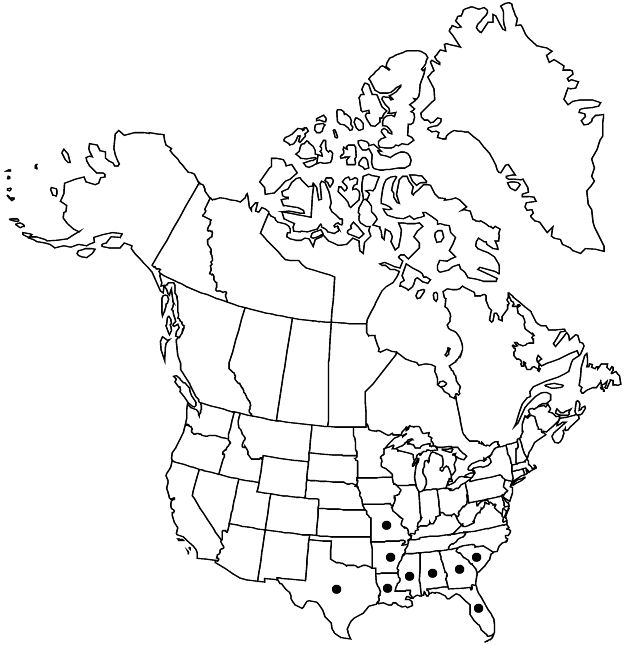Difference between revisions of "Crataegus viridis var. lanceolata"
Ann. Missouri Bot. Gard. 22: 561. 1935.
FNA>Volume Importer |
FNA>Volume Importer |
||
| Line 11: | Line 11: | ||
|label=Endemic | |label=Endemic | ||
}} | }} | ||
| − | |basionyms={{Treatment/ID/ | + | |basionyms={{Treatment/ID/Basionym |
|name=Crataegus lanceolata | |name=Crataegus lanceolata | ||
|authority=Sargent | |authority=Sargent | ||
| + | |publication_title=Trees & Shrubs | ||
| + | |publication_place=2: 65, plate 130. 1908 | ||
}} | }} | ||
|synonyms={{Treatment/ID/Synonym | |synonyms={{Treatment/ID/Synonym | ||
| Line 33: | Line 35: | ||
|elevation=10–200 m | |elevation=10–200 m | ||
|distribution=Ala.;Ark.;Fla.;Ga.;La.;Miss.;Mo.;S.C.;Tex. | |distribution=Ala.;Ark.;Fla.;Ga.;La.;Miss.;Mo.;S.C.;Tex. | ||
| − | |discussion=<p>The range of <i></i>var.<i> lanceolata</i> is poorly documented; it appears to be rather common in Louisiana and extends into Missouri, into eastern Texas, and through Alabama to South Carolina. In its most extreme expression, it is readily distinguished; it intergrades with both <i></i>var.<i> ovata</i> and <i></i>var.<i> viridis</i>. The foliage, with its distinctive venation, and the usually small- and few-flowered inflorescences are characteristic. Particularly large, oblong leaf forms of <i></i>var.<i> lanceolata</i> have been referred to <i>Crataegus</i> interior.</p> | + | |discussion=<p>The range of <i></i></i>var.<i><i> lanceolata</i> is poorly documented; it appears to be rather common in Louisiana and extends into Missouri, into eastern Texas, and through Alabama to South Carolina. In its most extreme expression, it is readily distinguished; it intergrades with both <i></i></i>var.<i><i> ovata</i> and <i></i></i>var.<i><i> viridis</i>. The foliage, with its distinctive venation, and the usually small- and few-flowered inflorescences are characteristic. Particularly large, oblong leaf forms of <i></i></i>var.<i><i> lanceolata</i> have been referred to <i>Crataegus</i> interior.</p> |
|tables= | |tables= | ||
|references= | |references= | ||
| Line 57: | Line 59: | ||
|publication year=1935 | |publication year=1935 | ||
|special status=Endemic | |special status=Endemic | ||
| − | |source xml=https://jpend@bitbucket.org/aafc-mbb/fna-data-curation.git/src/ | + | |source xml=https://jpend@bitbucket.org/aafc-mbb/fna-data-curation.git/src/f6b125a955440c0872999024f038d74684f65921/coarse_grained_fna_xml/V9/V9_894.xml |
|subfamily=Rosaceae subfam. Amygdaloideae | |subfamily=Rosaceae subfam. Amygdaloideae | ||
|tribe=Rosaceae tribe Gillenieae | |tribe=Rosaceae tribe Gillenieae | ||
Revision as of 21:38, 24 September 2019
Stems: trunk bark light gray, ± exfoliating; 1-year old twigs gray. Leaves: blade ± lanceolate, narrowly elliptic to narrowly obovate or oblong, 2.5–6 cm, thin, base cuneate, lobes 0 or obscure else rarely 1 per side, distinct, but not on most leaves, sinuses shallow, max LII 5(–20)%, margins serrulate-crenate, mainly in distal 2/3, sometimes entire, teeth to 1 mm, venation craspedodromous, sometimes semicamptodromous, veins 3–7 per side (often dividing before margin), apex acute to acuminate, surfaces glabrous except abaxially with tufts of hair in vein axils. Inflorescences: branches glabrous. Flowers: hypanthium glabrous.
Phenology: Flowering Apr; fruiting Sep–Nov.
Habitat: Moist, fertile, alluvial woodlands, agricultural derivatives of these
Elevation: 10–200 m
Distribution

Ala., Ark., Fla., Ga., La., Miss., Mo., S.C., Tex.
Discussion
The range of var. lanceolata is poorly documented; it appears to be rather common in Louisiana and extends into Missouri, into eastern Texas, and through Alabama to South Carolina. In its most extreme expression, it is readily distinguished; it intergrades with both var. ovata and var. viridis. The foliage, with its distinctive venation, and the usually small- and few-flowered inflorescences are characteristic. Particularly large, oblong leaf forms of var. lanceolata have been referred to Crataegus interior.
Selected References
None.